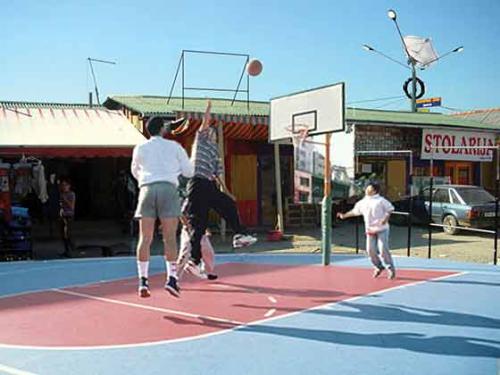Designs for the Real World
dal 12/9/2002 al 22/12/2002
Segnalato da
12/9/2002
Designs for the Real World
Generali Foundation, Wien
This exhibition will present selected projects by four artists who explore the design of our living environment and stand out for their interdisciplinary approach. Each in their own way, the various projects will address utopian or ecological design, design for the Third World, social engineering, urban development, urban areas of conflict, and the question of the responsibility of art in a new genre public art.

with Azra Aksamija, Marjetica Potrc, Florian Pumhösl, Krzysztof Wodiczko
This exhibition will present selected projects by four artists who explore
the design of our living environment and stand out for their
interdisciplinary approach. Each in their own way, the various projects
will address utopian or ecological design, design for the Third World,
social engineering, urban development, urban areas of conflict, and the
question of the responsibility of art in a new genre public art.
Azra Aksamija (Austrian architect, born in Bosnia in 1976) has developed a
project focusing on the creation and analysis of a new urban structure.
With its ethnically mixed population, the Arizona Market, the largest
black-market in Bosnia, established in 1997 by American SFOR troops,
provides an ideal object for examination. Aksamija considers the
self-regulation carried out by the residents of this center for
merchandise of all kinds as a positive phenomenon. Prototypes of the
interventions proposed by the artist a provocateur pole with all
necessary connections for electricity, water and sewerage, and a place
holder in the form of a sports groundwill be constructed for the
exhibition. A splitscreen projection featuring visual and acoustic
impressions of the market, and a timetable of the historical, political
and social situation serve to round off the picture that Aksamija presents
of the Arizona Market.
Marjetica Potrc (born in 1953 in Slovenia) follows a related approach with
her reconstruction of urban structures in suburbs or slums, mainly in the
Third World. The artist explores the buildings that are erected around
core unitssimple docking places for basic suppliesand reconstructs
them in the exhibition area. For the exhibition at the Generali
Foundation, she will reconstruct a building by the American architect
Samuel Mockbee (19442001) and his Rural Studio. Mockbee's aim is to
develop innovative housing designs for poor people in the south of
America. The special feature of the Butterfly-House is its striking
aliform roof, which is used to harvest rainwater. Shanty towns, gated
communities, mobile architecture are the focus of Potrc's photographic
series. The third part of her presentation in Vienna is a display of
innovative design, among other things for the Third World, as a ready-made
Florian Pumhösl's (born in Vienna in 1971) projects allow viewers to
experience the fascination for the esthetics and rhetoric of modernism and
the renewal movements that followed it, combined with critical analysis
and objective examination. The work shown at the exhibition, on or off
earth, 1996, makes visible the basic structures of the artist's esthetic
approach. The model-like reconstruction of designs by Victor Papanek,
including some from his book Designs for the Real World, the use of
publications and texts to contextualize them within historical discourses,
and the critical commentaries by the artist himself combine to form an
overall scenario that allows an interrogation of the utopian concepts
behind the alternative movement in the sixties.
The politics of the absurd of 1970s Poland were probably the force
behind the development of the first Vehicles by Krzysztof Wodiczko (born
in 1943 in Poland, lives in the USA). The Vehicle, 1972, for example, was
pushed forward by the artist's own back and forth walking motion. In the
late eighties, Wodiczko developed these vehicles further, this time taking
into account capitalistic reality, to create a series of Homeless
Vehicles. They provide this social group with a street tool that
responds to basic necessities of survival economy such as living, sleeping
and washing, as well as collecting and reselling cans and bottles. The
artist's intention to give marginalized groups the power of public
presence and speech is manifested in design projects like Alien Staffa
communications aid for migrants, as well as in his latest public
projections. In The Tijuana Projection, 2001, harsh personal experiences
of the woman population of the border city of Tijuana were projected live
in audio-visual form onto the monumental dome of El Centro Cultural
building. Krzysztof Wodiczko is the head of the Interrogative Design Group
at the Center of Advanced Visual Studies and the Director of Visual Arts
Program at Massachusetts Institute of Technology in Cambridge.
In the sixties Victor Papanek set new design standards with his Tin-Can
Radio, which can be used anywhere, independent of any electricity supply.
Over and above any esthetic issues, he put ecology, economy and
sustainability at the forefront of the design process. The artists'
projects for this exhibition explore the social, political and economic
living conditions within their specific frame of reference, and develop
approaches to a new design for the real world.
There will be a publication to accompany the exhibition (German/English)
Image: Azra Aksamija, Arizona Markt, 2001/02
Press office: Susanne Buder (+43 1) 504 98 80 ext. 24,
Artistic and Managing Director: Dr. Sabine Breitwieser
Generali Foundation
Wiedner Hauptstrasse 15
1040 Vienna
Phone (+43 1) 504 98 80
Fax (+43 1 ) 504 98 83
found.office@generali.at



